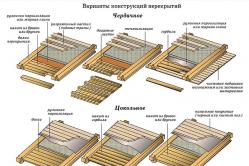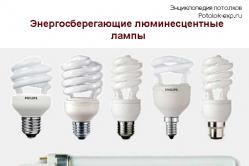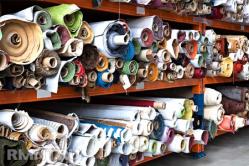Antipyretics for children are prescribed by a pediatrician. But there are situations of emergency care for fever, when the child needs to give the medicine immediately. Then the parents take responsibility and apply antipyretic drugs. What is allowed to give to infants? How can you bring down the temperature in older children? Which medications are the safest?
It is known that all roofing works are planned for the summer. This is due to the fact that it is almost impossible to completely protect against snow, while working at height in winter is associated with a risk to life.
Unfortunately, the danger of wetting the roofing pie exists in the summer, when a small rain can cause a lot of trouble and cause the insulation to become unusable. The fact is that almost all the thermal insulation materials used to insulate the roof, and dry the wet insulation is almost impossible.
Even a small amount of moisture that has fallen into the roofing cake significantly worsens the properties of the heat-insulating material, which leads to additional costs for heating. The soaked insulation is quickly destroyed, gives off an unpleasant smell and is subject to replacement.
In order to detect leaks in time and reduce the cost of repairing the roofing cake, the condition of the insulation is checked in the following cases:
There were traces of drops or streaks in the attic structures;
The roof of Onduville has chips, cracks or loosely adhering elements;
Onduvilla's snowbags have been squeezed.
What should I do if the insulation is wet?
It happens that a strong or prolonged rain begins during the replacement of the heater. In this case it is necessary:
Assess the condition of the thermal insulation material. If the roofing cake is partially covered with an insulating film, it must be removed;
The wet thermal insulation material is not suitable for further use and must be replaced with a new one. Neglect this rule is impossible, because in conditions of high humidity and a positive temperature on wooden structures, a fungus appears, and the decay process begins, which will necessarily lead to costly overhaul;
A new insulation must be immediately covered with a protective film. To eliminate leaks and ensure the effective operation of the roofing cake, the film must be installed in strict accordance with the manufacturer's instructions.
How to protect the heater from getting wet during the installation of the roof?
In order to avoid wetting the insulation when installing the roof, the following rules must be observed:
Before laying the thermal insulation material, pre-cut the insulation film on the required length;
Lay the heater and immediately cover it with an insulating film. All joints and laps of the panels carefully glue the mounting tape, fix the film on the rafters with a construction stapler;
Fix the panels with the beams of the control box. In order not to damage the film, move only on the flooring from the boards.
These rules will quickly cover the roofing cake and reliably protect it even from a heavy rainfall, and the installation of Onduville can be completed in dry weather.
Arkady Shchelyunin, Astrakhan. Question: Good afternoon, it's raining, autumn. Do not have time to make cotton wool on the facade of a keramzit concrete house. How now to be? Rains are coming every day. We are afraid that cotton wool is getting wet. Then winter. How to dry it?
Sergey Zaitsev, Moscow, specialist.
Answer: Good afternoon, Arkady. In response to your question, I can advise you the following. First, you are right. If it falls under a strong and prolonged rain, it will absorb moisture. Despite all the advertising assurances of the producers, on the photo with beautiful drops of water on cotton wool, however, the basalt heater absorbs moisture and is very excellent.
Therefore, it is impossible to wet it under heavy rain. If during the installation of cotton wool on the walls will rain - it's not scary. But if you keep it in the rain for a day - then it really does not dry up before installation.
So, we do 3 things.
Protection of cotton wool from rain to installation
We store ready-made cotton wool by the bales right next to the walls, preferably inside the room. In this case, it is possible to feed for mounting on the walls in the first or second floor windows, as it is more convenient.
Further, if the wall is deaf, we make a temporary canopy of boards and film next to it. Nothing global is needed, the main thing is that water drains to the ground, and not to cotton wool. Although it is packed in film bales, but this is not protection from heavy rain.

Further, we understand that in heavy rain, especially during prolonged autumn rains, all the water underfoot, the earth does not have time to absorb so much water. Vatu in bales and sheets on the ground do not add up, even under a canopy. It is best to use the most common wooden pallets. Their height, 15 cm, enough to wool does not get wet from the ground.
Protection of cotton wool during installation
To the basalt insulation is not wet during installation, it is necessary to protect the installation site from rain. For this purpose it is very convenient to use inventory forests. And on these forests, on the upper rails of the upper row, lay the boards and pull the film.
It will turn out cheap and angrily. Will be in the dry not only building materials, but also the installers, who work on the walls.
 That's exactly how we do the "roof" on the scaffolding so that the wool does not get wet and the installers are dry.
That's exactly how we do the "roof" on the scaffolding so that the wool does not get wet and the installers are dry. To divert rainwater from the film roofs on the forests, it is easiest to use 3-4 fan tubes with a diameter of 110 mm, into which water accumulating on the film will merge. This will not get wet under the unexpected "waterfall", when the water that does not have a sink, will bend the film and pour down in the "unfortunate" place.
Protection of basalt insulation after installation
And, of course, right after the installation of the basalt insulation on the wall, this area is closed. This protects the already mounted cotton wool on the walls from oblique rain.
The membrane itself does not tolerate ultraviolet very well, so do not hesitate with the subsequent decorative coating - siding or some other that you have chosen.
If you do not ventfasad, but, then there is especially no need to worry. The plaster layer will calmly close the cotton wool, it will still get a little wet during the installation.
-
The question is asked by Andrey Sukhorukov, Perm: Hello, dear colleagues! Would you like to clarify how you can protect vinyl siding from the sun and frost? I look at the neighbors ...
So, personally, do you think the growing prices for electricity and gas make you think about saving energy resources? Try to answer honestly this question. If yes, then this material ...
For and inside the mineral wool is used, the characteristics of which make it possible to make your home warmer and more comfortable. Minvata is a thermal insulation material that will help warm your house in winter, that is, keep heat from the heaters in the room and cut expenses twice during the heating season.
Also you will have the opportunity to insulate the walls of your house with your own hands, following the installation rules. As a rule, the walls of houses are insulated with external thermal insulation, and not internal.
The main reason for this solution is the saving of the internal space, also you can protect the bearing structures from the atmospheric effect.
If you have a solution for warming the inside of the house, then it is worth considering the fact that you will also have to install a vapor barrier layer, and this will prevent the natural ventilation of the rooms.
And if the house is insulated from the outside, you will have the opportunity to reconstruct the facade and change your house. It seems that the insulation of a country house or mansion is a laborious process that only masters can do, but it is not, it will be easy to do this work yourself, even if you did not have experience in it.
Types of mineral wool
If you need, then it is necessary to buy facade cotton wool, as for external and internal insulation of mineral wool, its characteristics are different.
One of the main features of façade wool is its moisture resistance, that is, it has a high degree of hydrophobicity.
The density of the facade mineral wool is very high and the ability to repel moisture separates it from a number of similar insulants.
Types of mineral wool:
- fiberglass;
- basaltic;
- stone.
Also, the great advantage of mineral wool is fire resistance. Manufacturers produce insulation in the form of mats or slabs of different thickness: 5, 10 or 15 cm.

Preparation of walls for insulation
If you think that minvata, the characteristics of which are suitable for your home - a good insulation, then you must first prepare the walls for finishing. If the walls have plaster, it is necessary to remove it to a brick, wood, concrete or stone, depending on what the walls of the house are made of.
In the event that the walls have level differences of more than two centimeters, then they need to be eliminated. Clearing the walls of dust and dirt, you can cover the prepared walls with a primer.
You will need two kinds of mineral wool, which will differ in density. The soft plate is laid against the wall, since such cotton wool can fill all the irregularities of the wall. Put the hard board on a soft one, so you will form a smooth surface of the walls from the outside. The total width of the insulation should not be more than 10 centimeters.

Work on the insulation starts from the bottom, the plates are glued with a special glue.
Warming the wall, you will need to adhere to such a sequence: a wall, a heater, reinforcing mesh on dowels and facade plaster.
Also you can warm the house, making a ventilated facade. This will help prevent the formation of wet condensate, which harms the minvate. Even in spite of their high moisture resistance, they let through the water evaporation through their thickness, which can spoil both mineral wool, deforming and delaminating it, and the walls of the house.
Disadvantages of mineral wool
As a rule, the characteristics of mineral wool have more positive qualities than disadvantages, but all the cons of this insulation must be taken into account. One of the main drawbacks of a heater is the loss of mineral wool of its heat-insulating qualities in case of wetting.
If suddenly it happened that, for example, the water supply line broke and the mineral wool was soaked, it must be thoroughly dried. Warming the house from the outside, take care of the protection of the mineral water. You can use a heater under siding, this not only protects it from moisture, but also makes your facade beautiful.
Fibers of stone wool are not prickly, but still small pieces can go up as dust. There is a danger, as these pieces can be inhaled, and this is very dangerous for health. Also in the composition of mineral wool is a formaldehyde resin, which can poison you with phenol.

If you stick to safety and work in a respirator, then no danger to you is not terrible.
Phenol at room temperature will not stand out if you have purchased a good quality mineral wool, but it is better to cover the surface of the insulation with a vapor-proof polyvinyl chloride film.
When the mineral wool is heated to a temperature above room temperature, phenol will be released and can affect your health. If you do not have the opportunity to prevent a strong heating of mineral wool, then buy basalt cotton, which is of higher quality, however, it will cost more. safe for health.

Heat insulation mansard roof - this is the three benefits in one solution. Firstly, the house becomes significantly warmer. Secondly, heating costs are reduced by 30-50%. Well, and the third: there is a residential floor. We made the walls - and got instead of a littered attic cozy rooms under the roof.
A popular roofing heater is mineral wool. Material with excellent performance, non-flammable and affordable.
Why does the mineral wool get wet?
The coefficient of thermal conductivity of mineral fibers is 0.031-0.042 W / m 2 * K. This means that the layer of glass wool 5 cm thick is equal to the thermal effect of a meter brick wall. But the thermal insulation properties disappear when moisture enters the fibers.
Reasons for wetting:
- Damaged waterproofing membrane when laying insulation. Too much tension on the canvas, accidentally pierced with a nail or a screwdriver.
- Do not paste the joints of the film. As a result, the condensate penetrates the fibers of the mineral wool.
- Insufficiently tightly fixed waterproofing near vent and chimneys.
- A poor-quality diffuse membrane was used.
Risk of wetting: the risk of a wet insulation
Wait for that wet roof thermal insulation will dry up on its own - a dangerous delusion. Wet mineral wool does not retain heat. In addition, it becomes a source of unpleasant odor, the spread of mold and bacteria. Well, and "cherry" in the troubles of the roofing pie: wooden rafters are being destroyed, the metal elements of the structure are rusting at an accelerated pace. The result is a roof overhaul.
To avoid problems, check the condition of the insulation:
- if there were any drips or drops on the walls of the attic;
- on the roof, cracks appeared, the roofing elements were loose;
- in places where snow accumulates, the roof is bent.
Wet business: how to deal with a damp heater
Having discovered that the thermal insulation is wet, there are two options for the development of events. If the fibers are wet only from above and in a small area, it is possible to dry this place. For this, two conditions are necessary: draft and clear warm weather.
Wet through the heater URSA experts recommend to replace. The main thing is that when installing new material, do not make the same mistakes.
How to fix the problem and leave the insulation dry
To protect the newly insulated roof from getting wet, consider professional advice:
- it is desirable to carry out installation in dry weather;
- before installing the mineral wool, cut the waterproofing film into strata of the required length;
- fixing the insulation, immediately cover it with a protective membrane;
- glue the joints of the film, fasten the rafters with a construction stapler;
- walk only on the boardwalk, so as not to tear the waterproofing.
Select special insulation material for pitched roofs and waterproofing to it can be on http://www.ursa.ru/construction-solutions/skatnie-krishi/.
Proven materials, competent installation and the roof will remain dry in any weather!



